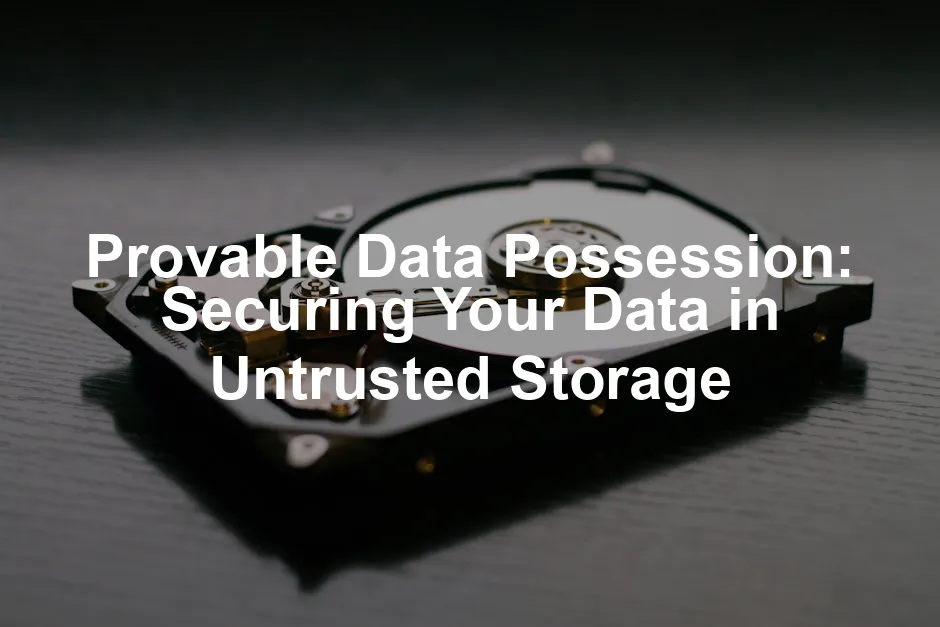Introduction
Provable Data Possession (PDP) is crucial for cloud storage. It ensures users can verify their data remains intact without downloading it. However, relying on untrusted storage poses risks, such as data loss or tampering. This article will explore PDP, its significance, and applications in modern data management.
Are you tired of losing your precious data? Look no further! With a reliable External Hard Drive – WD 5TB Elements Portable, you can securely store and back up your data without a hitch!

Summary and Overview
PDP allows clients to confirm data integrity and availability in cloud environments. With the rise of cloud storage, verifying data has become essential. PDP employs methods to ensure data remains secure, including metadata management and proof generation. The following sections will discuss what PDP is, its historical development, key components, advantages, limitations, and future trends. Each part will reveal how PDP enhances data management and security.
Looking to keep your data safe and sound? Consider using USB Flash Drive – SanDisk 128GB Ultra. It’s small, portable, and perfect for keeping your important files close at hand!

Understanding Provable Data Possession
What is Provable Data Possession?
Provable Data Possession (PDP) is a method that allows clients to verify their data’s integrity stored on untrusted servers. This technology is vital for data management, especially in cloud storage. It ensures that the data remains intact and unaltered without the need to download it. Traditional verification methods often require data retrieval, which can be inefficient and slow.
Using PDP offers several advantages over conventional techniques. For instance, it minimizes bandwidth usage by allowing clients to check data without retrieval. This efficiency is crucial as the cloud storage market continues to grow. According to recent statistics, the global cloud storage market is projected to reach $137.3 billion by 2025. With more data stored online, ensuring data integrity becomes increasingly important.
PDP is particularly useful in scenarios where data security is paramount, such as healthcare and finance. By adopting PDP, organizations can enhance their data security measures and ensure that their information remains protected. Consider implementing PDP for your data security needs to enjoy these benefits.
Understanding the concept of provable data possession can significantly enhance your approach to data management.
Historical Context and Development
The concept of Provable Data Possession emerged from foundational research by Ateniese et al. in 2007. Their groundbreaking work introduced a model that allowed clients to verify data integrity at untrusted storage providers. This research laid the groundwork for the development of various PDP schemes.
Since then, the technology has evolved significantly. New models have emerged, enabling dynamic updates and improved verification processes. Researchers have focused on enhancing security against potential threats, including quantum attacks. The adoption of PDP has gained traction, with increasing interest from industries relying on cloud storage.
The impact of PDP on data storage solutions is profound. It has transformed how organizations approach data integrity and security. As more businesses recognize the importance of these technologies, the citation counts for foundational research continue to grow, reflecting its relevance in contemporary practices. Reflect on how these developments shape your understanding of data management today.

To further enhance your understanding of cloud storage, check out the insightful book “Cloud Storage Forensics” by Darren Quick. It’s a must-read for anyone delving into data management!
Key Components of Provable Data Possession
Metadata Management
Metadata plays a crucial role in Provable Data Possession (PDP). It helps verify data integrity without needing to download the actual data. Essentially, metadata is data about data. In the context of PDP, it includes information like file size, block locations, and checksums.
To manage metadata effectively, organizations should adopt several strategies. First, keep metadata minimal yet informative. Only retain essential information to reduce storage overhead. Second, ensure regular updates to metadata as data changes. This keeps the verification process accurate.
Security is also a major concern when handling metadata. Use encryption to protect sensitive metadata from unauthorized access. Implement strict access controls to limit who can view or modify metadata. Interestingly, metadata can be significantly smaller than the actual data—often just 1-5% of the total size. Therefore, effective metadata management not only enhances security but also improves storage efficiency.

Speaking of storage efficiency, consider investing in a NAS Storage Device – Synology DiskStation DS220+. It’s a fantastic way to manage and back up all your data securely!
The Challenge/Response Protocol
The challenge/response protocol is a fundamental mechanism in PDP. It allows the client to verify that the server holds the correct data without needing to retrieve it. The process begins when the client issues a challenge to the server, requesting proof of data possession.
The server then responds with a proof that demonstrates it still possesses the data. This method is efficient, as it requires minimal data transfer. The challenge/response mechanism is known for its security implications. It significantly reduces the risk of data tampering and unauthorized access.
Comparatively, this protocol outperforms traditional verification methods, which often require downloading large files. Performance metrics show that challenge/response protocols can operate at speeds exceeding 99% efficiency in verifying data. As a result, organizations can maintain data integrity without overwhelming their network resources.
Are you considering implementing this protocol? It could be a game-changer for your data management strategy.

Advantages and Limitations of PDP
Advantages of Using PDP
Implementing Provable Data Possession (PDP) in cloud storage offers numerous benefits. First, it enhances cost efficiency. Compared to traditional verification methods, PDP significantly reduces I/O operations. This means less bandwidth is consumed during data checks, leading to lower costs.
Additionally, PDP boosts data integrity. It allows clients to verify their data without needing to download it. This not only saves time but also keeps sensitive information secure from potential breaches. In fact, studies show that using PDP can lead to a 50% reduction in resource use when compared to older methods.
Another advantage is the improved cloud efficiency. As organizations store more data online, ensuring its safety and integrity is crucial. The benefits of PDP make it an attractive option for those seeking robust data management solutions. Consider adopting PDP to enhance your data management strategy and security.

For those diving deeper into data management, the book “Data Integrity: A Practical Guide to Data Management” by David S. Brown is an excellent resource that complements your learning!
Limitations and Challenges
While PDP has significant advantages, it also presents certain limitations and challenges. One major limitation is that conventional PDP models struggle with dynamic data. They are primarily designed for static information, which means any updates require reprocessing. This can hinder efficiency in fast-paced environments.
Moreover, challenges in dynamic data management can arise. For instance, frequent data modifications may lead to increased overhead. In some cases, organizations may find it hard to maintain data integrity during these updates.
Additionally, security concerns exist in specific contexts. For industries with stringent compliance requirements, PDP may not always provide the needed assurances. Failure rates in existing implementations highlight these potential issues. As you consider implementing PDP, think critically about when and where it is most applicable.

Future Directions in Provable Data Possession
Innovations and Trends
The future of Provable Data Possession (PDP) looks promising, with several exciting trends on the horizon. One significant development is the integration of blockchain technology. This combination enhances security and transparency, making it easier to verify data integrity without relying solely on third-party providers.
Advances in dynamic PDP models are also noteworthy. These innovations allow for efficient data verification even as data changes frequently. Organizations can update their stored files without extensive overhead, maintaining data integrity seamlessly.
Future research directions will likely focus on improving existing PDP schemes. This includes exploring more robust algorithms that can withstand emerging threats, particularly quantum computing attacks. Investment trends indicate a surge in funding for data security technologies, highlighting the growing importance of these advancements.

Stay informed about these exciting developments to enhance your data management strategies. And while you’re at it, consider grabbing a Raspberry Pi 4 Model B – 4GB RAM for your next project; it’s a fantastic tool for tech enthusiasts!
Conclusion
Provable Data Possession plays a crucial role in maintaining data integrity in untrusted storage environments. By enabling users to verify their data’s authenticity, PDP addresses significant concerns about data loss and tampering. While it offers many advantages, organizations must also be aware of the challenges in implementing it effectively.
Adopting PDP can significantly improve data management strategies, ensuring that sensitive information remains secure. As the digital landscape continues to evolve, considering PDP as part of your data management framework is wise. Embrace this technology to safeguard your data today. And if you’re looking for a great book on cloud computing to accompany your journey, check out “Cloud Computing: Concepts, Technology & Architecture” by Thomas Erl.
Please let us know what you think about our content by leaving a comment down below!
Thank you for reading till here 🙂
All images from Pexels




